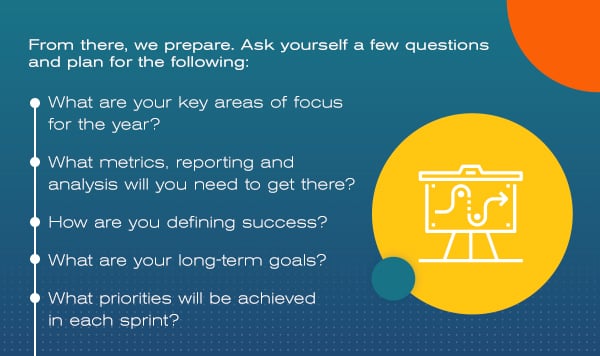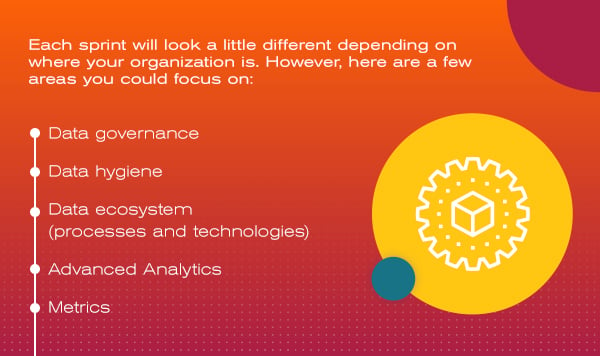So, you’re ready to use data to empower your fundraising and marketing decisions. Now what?
First off, congratulations! Up-front commitment is often the hardest thing to achieve but is necessary to begin.
We know adopting a data-driven mindset can be overwhelming for nonprofits of all sizes. That’s why I encourage many of the organizations I work with to approach it in digestible chunks, or sprints.
For those of you who are unfamiliar with the software development world, sprints are time-boxed periods ranging anywhere from a few days to a few weeks where the project teams works together to achieve a specific product development goal.
The beauty of this type of roadmap setting is that you can shape it to fit your needs and more easily measure progress. Whether you do four sprints a year, or choose to do more, you can block out dedicated time for heads-down work on your data.
Let’s break down what these sprints look like and how this roadmap will provide one source of truth for all your data-driven fundraising decisions.
Phase 1: Prepare
Any major change requires that the proper planning and prep work be done in advance. The idea behind sprints is that you have everything you need up front so that you can accomplish your work uninterrupted.
In this case, I recommend beginning by forming a Data and Analytics Task Force.
Your task force should be made up of key players from across your organization who will play a role in revolutionizing your data processes. This could include, but is not limited to, your Chief Data Officer, VP of Marketing, VP of Development, Program Directors, IT, Database admins, CRM admins and any of your agency or vendor partners if needed.
By including touchpoints from different departments within your organization, not only will you get unique perspectives and more ideas, but you’ll also encourage employee engagement and buy-in.

It’s important to have clearly outlined objectives before you begin – otherwise you won’t accomplish what you set out to do during your sprint. This preparation process can take anywhere from 1-2 months depending on how much planning your organization needs to get done.
Phase 2: Sprint
Now to the fun stuff! Once the prep work is done and you’ve identified what you want to accomplish in each of your sprints, you’re ready to begin.

Each sprint may have a slightly different team of people doing the work, and the task force can help identify who and what needs to be a part of it. But the idea is that, during this time period, the appointed team is working exclusively on accomplishing the goal that was set for the sprint.
Realistically, these may have to happen once a quarter, but organizations could start to see results within six months.
Phase 3: Assess
When you’ve recovered from your sprint, it’s important to stop, assess and review whether you accomplished your goals.
Measure the outcomes each sprint contributed to, and any wins, losses or areas of opportunity. If you assess after each sprint, it’ll be easier to pivot and make any adjustments along the way.
Phase 4: Maintain
In the software industry, your code is under constant maintenance. It experiences updates, bug fixes and new features.
The data process for nonprofits is no different. A successful data program is constantly monitored, optimized and adjusted so that you can continue to receive accurate and trusted results.
Things like data governance and data hygiene have to be maintained, otherwise they can get out of control over time. When you take time to do these housekeeping tasks, you’ll maintain all the work you’ve accomplished during your sprint. Keep in mind that the foundational mission is to have one source of truth at all times.
A project like this is a big undertaking. But with commitment, vision and a little hard work, your organization can begin to use fine-tuned metrics to make data-driven decisions.





Leave a comment: